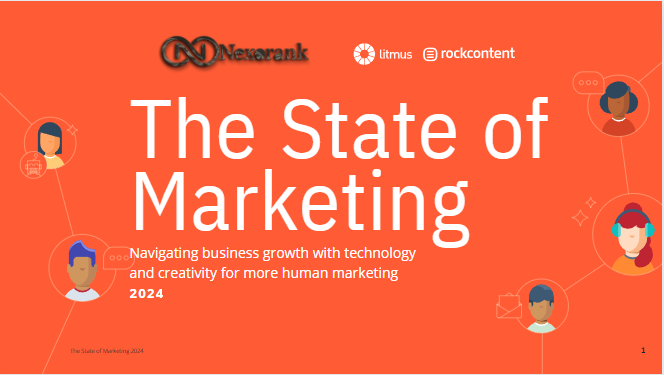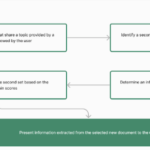If you’re like me, you’ll wish you had more energy and funds to tackle your day-to-day tasks to think of game-changing ideas and then create memorable brand experiences.
As AI is fast becoming an ultimate marketing tool in a variety of quests but it’s also causing our environment (and our competition) to grow even faster.
Download Now: Free State of Marketing Report [Updated for 2024]
[fluentform id=”9″]
Utilizing data from our survey of 1460 B2B & B2C marketers around the world In this article, we’ll look at the most popular trends in marketing of 2024, the ways AI is set to continue to transform the landscape of marketing and how you can gain the attention of your customers in the new age of marketing
Key Findings:
- AI is rapidly growing into the best marketing tool, however, there are still obstacles to adoption such as security concerns for jobs branding reputation, job security, and a lack of understanding about how to utilize AI.
- Social media applications could generate greater ROI than ever before in 2024, as they transform into e-commerce platforms with no friction.
- Apps that focus on video like TikTok, Instagram, and YouTube will experience the greatest growth by 2024, even though Facebook is still the most popular and is tied with Instagram for the highest return on investment. s.
- Short-form video has the highest return on content and earns more money than other formats.
- Marketers will use the power of social media using first-party data, first-party information, as well as AI tools to connect with their audience after the Chrome third-party cookie elimination.
The Top Marketing Trend of 2024
1. AI is now the ultimate content marketing assistant.
Marketing trends can’t be discussed without AI and its impact of AI is so significant that it occupies the first and second places on our list.
The most important lesson to take away to take away is the fact that AI is fast turning into the best marketing assistant which is why 64% of marketing professionals are employing AI, as well as 38 percent of those who aren’t yet have plans to implement it by 2024.
AI is increasing in importance. Actually, Sean Downey Google’s President of Americas and Global Partners, believes that AI will be the most significant trend by 2024.
He stated to Nexorank on this blog post, “It should come as no surprise that, in 2024, the most significant marketing trends will revolve around the potential in AI. Marketing professionals today are confronted with a number of challenges in navigating changing consumer expectations and consumerism patterns in the present media landscape that is a blur and rapidly changing and all the while delivering better business outcomes.”
He says, “The AI opportunity is coming at a time of transformation for everyone, including marketers. In fact, in addition to connecting brands and products to people, more than ever before, marketers need to be growth drivers for their companies.”
Key Findings:
- AI is fast being regarded as the most effective marketing assistant however, it’s still battling adoption hurdles such as security concerns for jobs as well as brand image and the lack of understanding on how to make use of AI.
- Social media apps may generate greater ROI than ever before in 2024, as they transform into e-commerce platforms that are frictionless.
- Applications that are based on video such as TikTok, Instagram, and YouTube will experience the greatest growth by 2024, even though Facebook is still the most popular and tied with Instagram for the highest return on investment. s.
- Short-form video is the most efficient format for return on content and earns more money than other formats.
- Marketers will rely on the power of social media as well as first-party data as well as AI tools to connect with their audience following the removal of third-party cookies from Chrome.
The Top Marketing Trend of 2024
1. AI is fast becoming the ultimate marketing assistant.
Marketing trends can’t be discussed without AI and its impact of AI is so massive that it is taking the first and second places on our list.
The most important lesson to take away to take away is the fact that AI is fast turning into the best marketing assistant which is why 64% of marketing professionals are currently employing it, as well as 38 percent of those not yet have plans to implement it by 2024.
AI is increasing its importance. Actually, Sean Downey Google’s President for Americas and Global Partners, believes that AI is the biggest trend by 2024.
He wrote to Nexorank on this blog post, “It should come as no surprise that, in 2024, the largest marketing trends will revolve around the potential in AI. Marketing professionals today are confronted with the challenge of navigating the ever-changing consumer preferences and habits of consumption in the current media landscape that is a blur and rapidly changing — while also delivering better business results.”
He continues, “The AI opportunity is coming at a time of transformation for everyone, including marketers. In fact, in addition to connecting brands and products to people, more than ever before, marketers need to be growth drivers for their companies.”
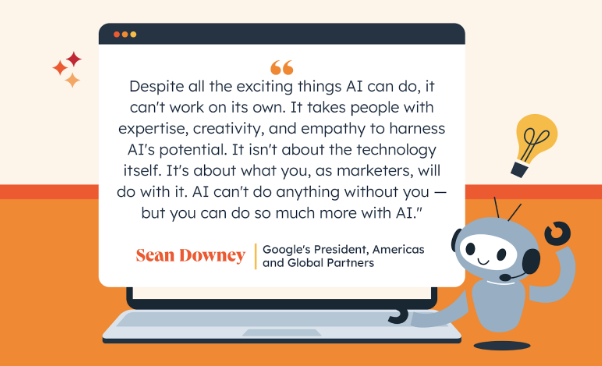
It’s interesting to examine how marketers perceive AI using it 60% believe that AI acts as an assistant to assist them in their work and 20% believe that AI as primarily taking on menial tasks.
There’s no doubt the fact that AI can make a huge impact on the world of marketing by 2024.
88% of marketers think that generative AI has transformed the way they produce content by 2024. 63% of marketers believe that by 2024, the majority of content will be produced at a minimum using the generative AI
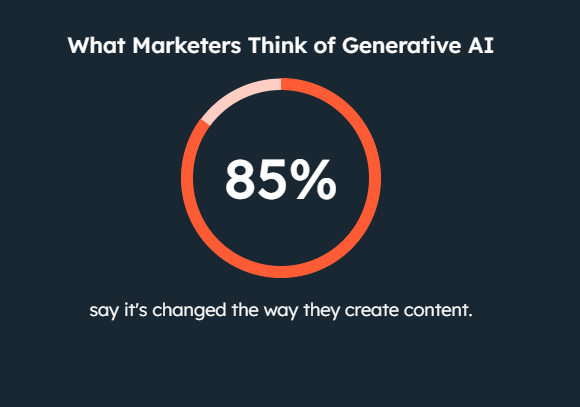
Marketers who employ artificial intelligence (AI) generative AI have seen positive results. They say it allows them to create significantly more high-quality content that is more effective.
According to Briana Rogers, Head of Product Marketing at Miro I was told by Briana Rogers, Head of Product Marketing at Miro, “Marketers will have to learn how to integrate AI into their work.”
She says, “The space is moving so quickly and we need to experiment with everything … from the more well-established use cases — like leveraging machine learning to improve ad buying, or creating predictive customer value models — to newer spaces, like identifying patterns in user research and data, assisting in creative development, and building full customer campaigns that are powered by AI.”
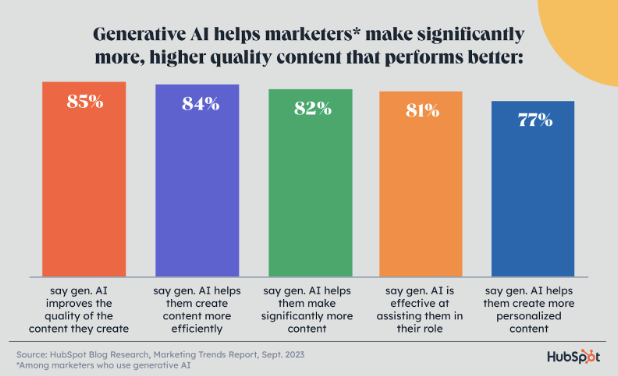
81 percent of marketers who employ the generative AI believe it’s efficient in helping them with their work according to. In particular, it aids them:
- Improve the quality of the content they produce (85 percent)
- Produce content more effectively (84 percent)
- create substantially more content (82 percentage)
- create more personalized content (77%).
And on top of that 56 percent of marketers using the generative AI to create content say that this content is more effective than content that is not created using it.
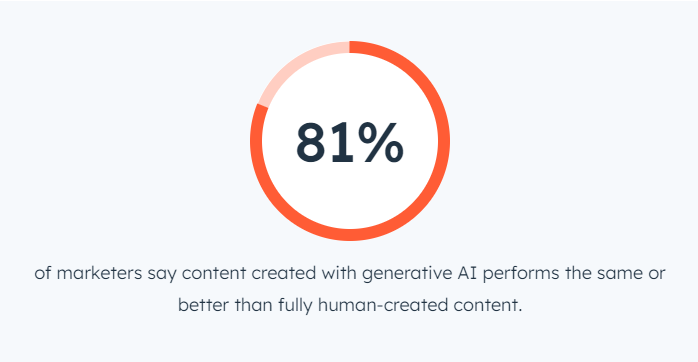
Our survey also shows that marketers who employ AI/automation devices are 99 percent more likely declare their strategy for marketing was extremely effective in the past year than those who do not.
However, the main point to remember is AI isn’t meant to be used to replace the entire team of content creators. The consumer will not want this, and neither do platforms such as Google.
Indeed, a report by one of our colleagues, Curtis del Principe, pointed out the sentence handed down to a single organization after they stole thousands of posts using AI in what we call”an “SEO Heist.
If you aren’t able to produce all your content using AI in full, how do you still use AI to maximize the value in your content strategy?
How Marketers Use AI for Content Creation
The marketing professionals we interviewed informed us that the most popular uses for the generative AI include data analysis, research and the creation of content (but do not just stop here)
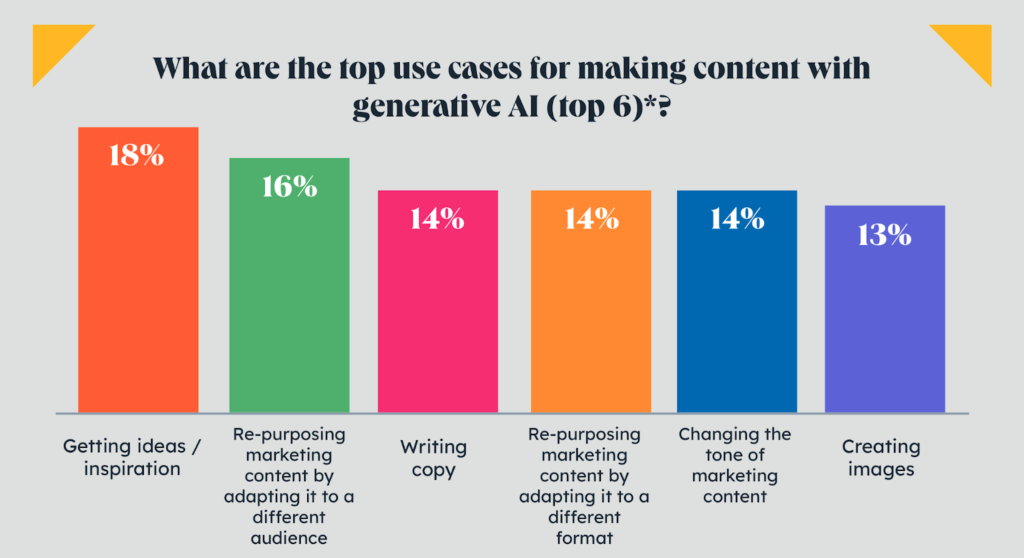
Additionally, our study shows marketers who employ AI/automation tools have a 95% higher chance declare their strategy for marketing was extremely effective in the past year than those who do not.
However, the main point can be made that AI should not take over your whole team of content creators. The consumer will not want this, nor will platforms such as Google.
Actually, a report from one of our coworkers, Curtis del Principe, has highlighted the harshness handed out an agency after they swindled thousands of posts using AI in what we call the “SEO Heist.”
In other words, if you’re not able to make all of your content using AI fully, how can you still use AI to maximize the value for your content strategy?
In the process of creating content, marketers don’t replace creatives or writers with AI. Instead, they use AI to create content.
- Innovating new angles or concepts,
- Re-purposing or modifying existing content for a new target audience, format or channel
- Basic copywriting or outline
- In addition, you can create images or simple videos.
With regards to the different types of content that marketers create, they use in generating AI to create, emails, social media posts blog posts, images as well as product description.
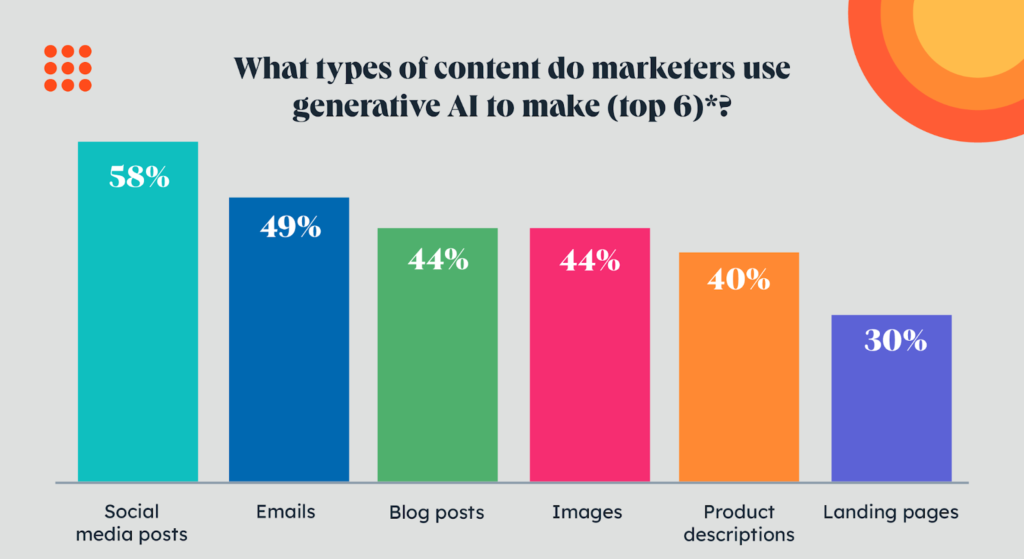
While that all sounds great, there are a few concerns to be aware of with AI we should talk about.Where AI Still Faces BarriersThe AI revolution is a huge change, so it’s no surprise that close to half of marketers are concerned about AI replacing their jobs. 23% even think marketers should avoid using generative AI altogether.But based on how marketers are actually using AI, it isn’t replacing their jobs, but acting as an assistant. Among marketers who use generative AI to write copy, just 6% use it to write the entire piece of content for them. 45% use it for ideas/inspiration, 31% use it for an outline, and 18% use it for a first draft.
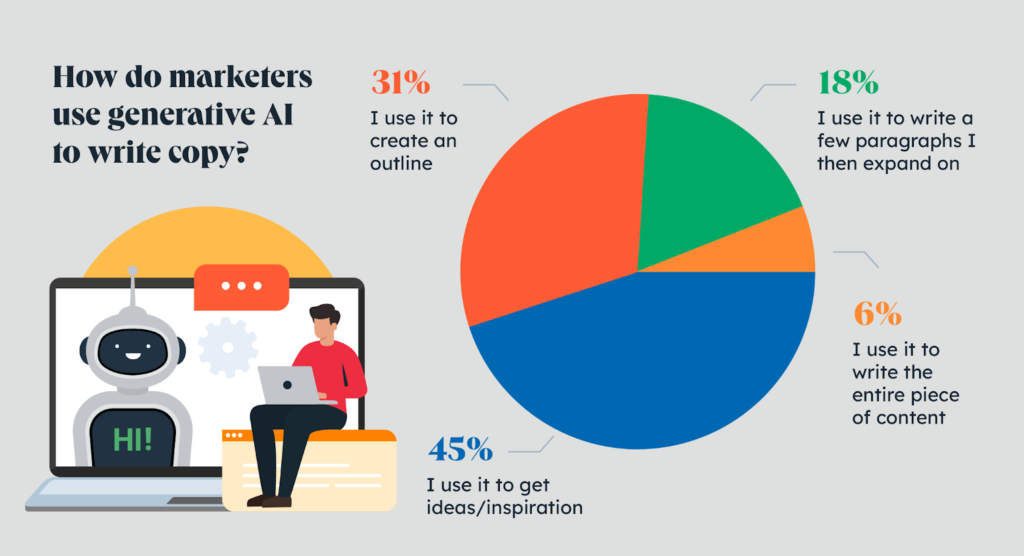
Additionally 95 percent of marketers who employ the generative AI for copywriting will make changes to the text as well as 44% making significant changes. Another concern is integrating AI across the entire workflow of marketers as 46% feel overwhelmed by the idea.

Prior to Next Of marketers using AI to write copy… 90 percent say they need to make minor to significant changes to the generated text. The good news is that companies are taking steps to assist, with 40 percent of marketers saying that they have appointed a new employee to help them leverage AI.Still it is a challenge, considering that AI being a relatively new technology only 21 percent of marketers have incorporated it into their everyday workflow. 32 percent of marketers are using AI to perform specific tasks, and 10% are in the testing phase. Of course, 36 percent of marketers don’t employ AI in any way – however, the 38% aren’t saying they’ll begin making use of AI in 2024.
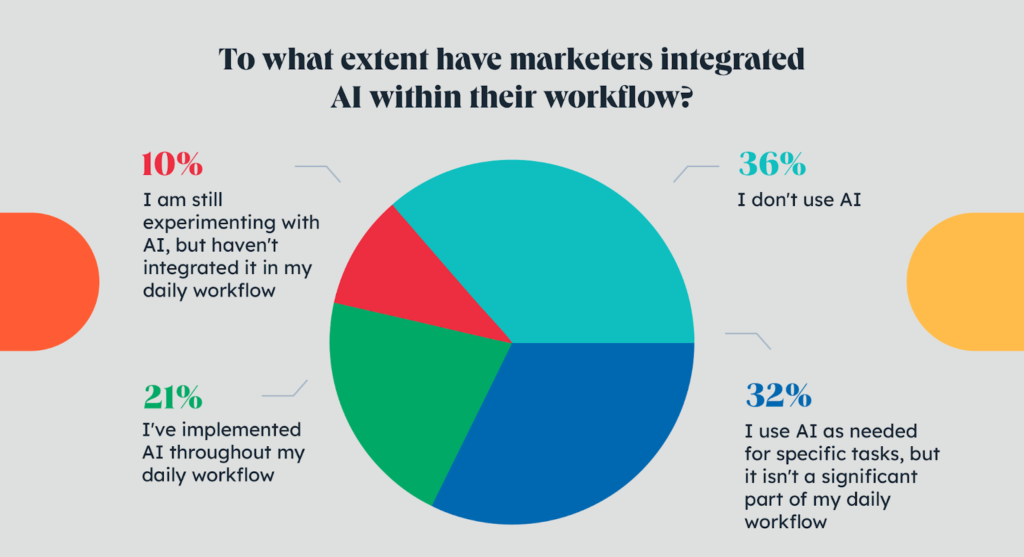
One last concern that is which is shared by 60 percent of marketers is that AI could harm the reputation of their brands because of bias, plagiarism or inconsistency with the brand’s principles. This is certainly an issue, however in the event that you’re employing AI in the role of an advisor it will be editing and observing the output at every step of the process. AI tools are also conscious of the issues and have already introduced tools to verify and source the information it gives out. For instance Google’s Bard allows you to verify the output against known information available on the internet to inform you whether it is confirmed by other sources, and providing the links to relevant sources.
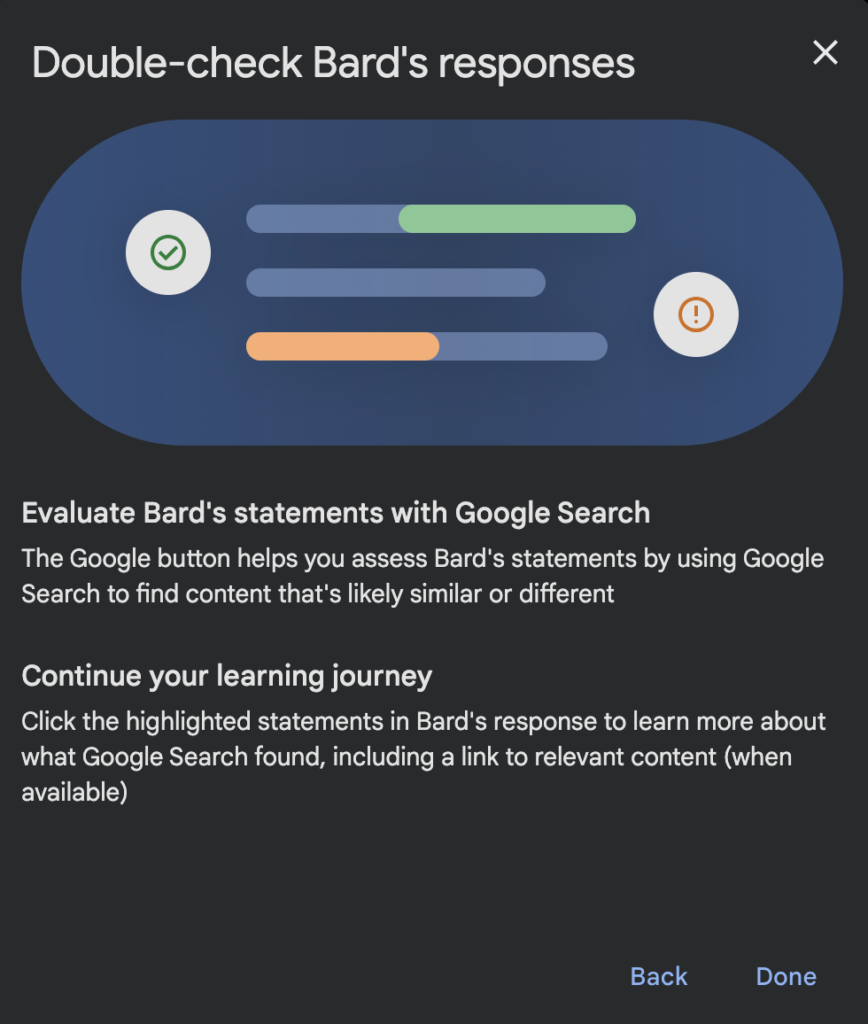
Luckily when companies employ AI implementation specialists and marketers get more comfortable with AI in the role of an advisor and as AI tools become more precise and reliable. We predict that the issues above will be addressed quickly.
Top Marketing Channels
2. It is perhaps the top ROI marketing channel and it is continuing to grow in tandem with ecommerce.
Social media is without doubt the top marketing channel. It doesn’t just have the highest ROI, but it’s also utilized by 43 percent of marketers.

The reason that social media is so successful is due to the fact that it has become an important shopping and product discovery channel as shopping is taking center on all platforms.
Marketers can create virtual stores that offer shoppers the ultimate buying experience, from discovering via influencer recommendations, to in-app purchases, as well as customer service through DMs.
Earlier this summer the Consumer Trends Survey found that 64 percent of Gen Z and 59% of those in the generation called Millennials and 47 percent of Gen X found an item on social media within the last three months. In addition to that social media is the top method of discovering products for the Millennial generation and Gen Z with Boomers and Gen X getting used to it fast.
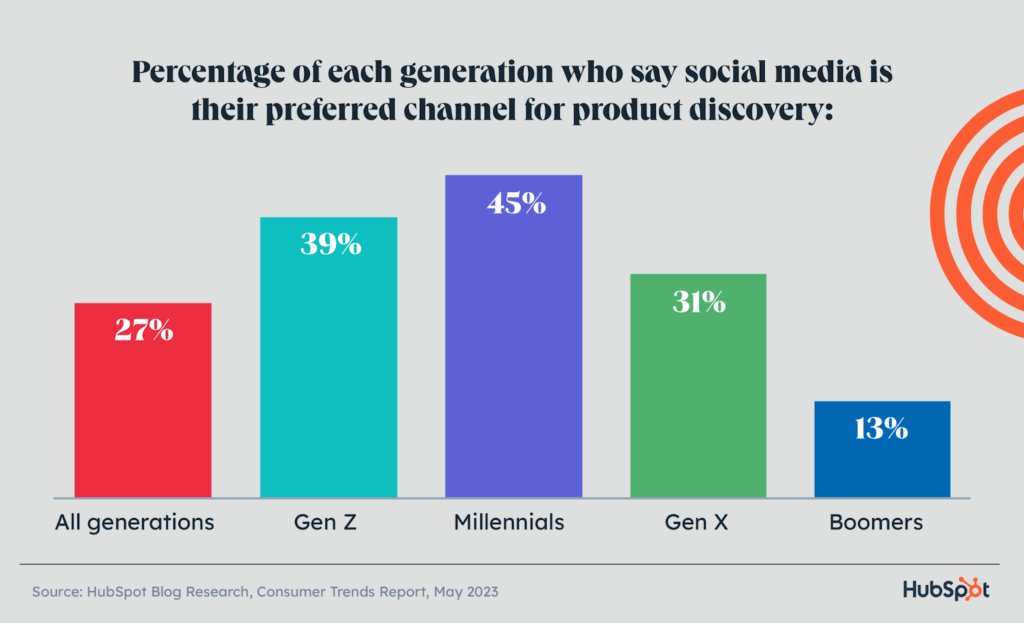
In addition that 17 percent of users on social media bought an item in the app within the last three months. In the same time period the majority of users purchased something on the basis of an influencer’s recommendation. 19% of them sent a direct message to get support.

Furthermore, every when we re-run and run our Consumer Trends Survey, the number of respondents increase dramatically. Therefore, it’s no surprise that marketers are swiftly accepting the concept of social selling.
Our survey on social selling also found that 87% marketers selling via social media say it’s efficient and 59% of them say they’re making more sales by 2023 than in the last year.
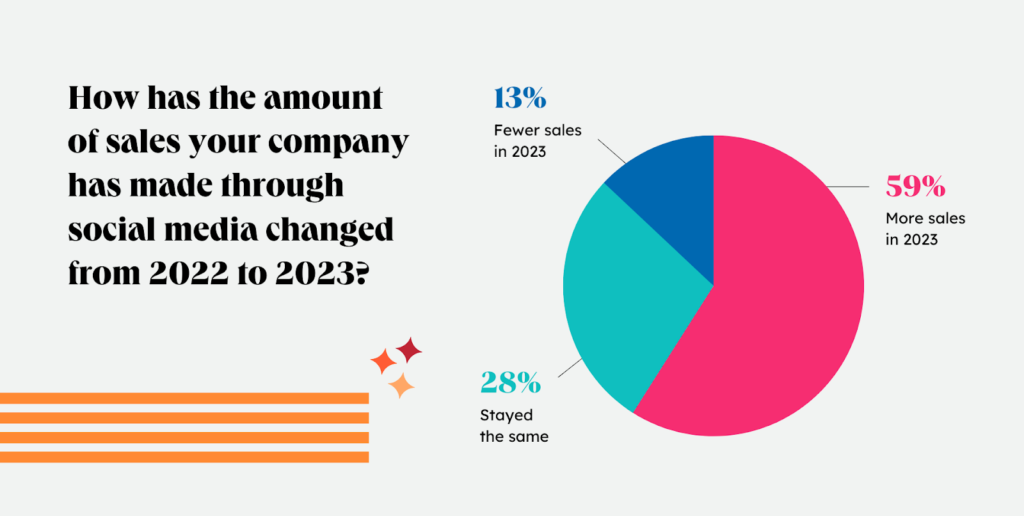
Currently 27percent of marketing professionals utilize Social Selling tools. while 23 percent rely on influencer marketing and 22% utilize social media for Customer service. Marketers have plans to make significant investments in these channels by 2024.Now having reviewed the advantages of the social media selling channel, we’ll take an glance at some of the efficient marketing platforms for the 2024.
The Top Trends in Content and Formats
3. TikTok, a video-centric app as well as Instagram and YouTube are experiencing the greatest growth however, don’t forget Facebook.
If you’ve been a fan of social media recently and you’ve noticed that the importance of video and marketers have reported that platforms with video content are the most efficient and provide the highest ROI.
Instagram along with Facebook, are the two most ROI-generating platforms and are followed by YouTube, TikTok as well as LinkedIn and X.
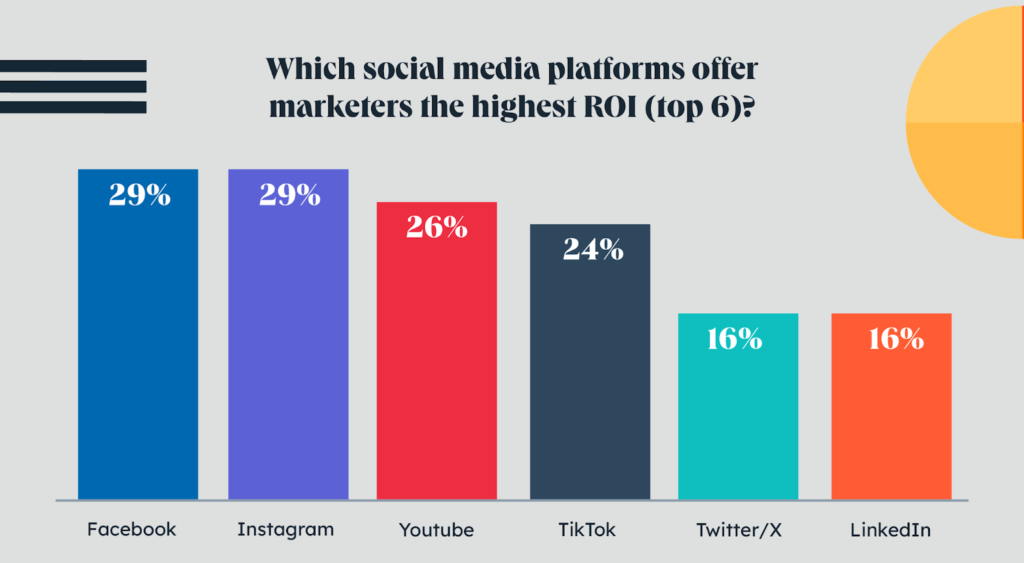
Facebook’s remains the most used platform used by marketers (57 percent) and is which is followed by Instagram (55 percent) as well as YouTube (52%)) as well as TikTok (44 percent) as well as TikTok (34%), X (39 percent) and LinkedIn (37 percent).

Although there’s no doubt that Facebook is still the most popular with regard to video, platforms such as TikTok, YouTube and Instagram will receive more investments in 2024.
56 percent of marketers who use TikTok plan to increase their spending in the coming year, which is the most that any of the platforms. Instagram and YouTube will also experience a major increase in their investments.

When it comes to first-time usage 27% of marketers that don’t utilize YouTube intend to use the platform in 2024. The next three are TikTok (25 percent) and Facebook (24 percent) as well as Instagram (23 percent).
However, the main social media battle of the moment is between Threads and X. Our research shows that marketers prefer the latest version of Twitter and 68% of them expect to have more success using the X platform over Threads in 2024.

At present, only 11percent of marketers are using Threads, while only 13 percent of those who do not are planning to use threads in 2024.
At this moment, you may ask you, “But are consumers I target engaging with these networks?”
Check out these deep dives for more:
- X vs. Threads: What Marketers Need to Know
- The Fastest Growing Social Media Platforms [New Data]
- Which Social Media Channels are Gaining & Losing Steam? [Consumer and Platform Data]
4. Short-form videos have the best return on investment and will experience the greatest growth of any content marketing format by 2024.
Since TikTok reinvigorated the virality of the millennials’ most-loved app, Vine, our blog team has been anticipating a short-form video renaissance.
Today there’s no contest that short-form video is the top media marketing technique, delivering the greatest return on investment. Short-form videos are also the most popular format, being used by 44 percent of marketers.

While short-form videos have been in vogue for a while and will continue to witness the fastest growth of any format by 2024, as marketers plan to invest more over any other type of format.

A majority (26%) of marketing professionals are planning to invest more more than other formats in 2024. This is the most of any format so far. In addition 57 percent of marketers using short-form video are expected to increase their investments in 2024, which is the largest growth for any type of format. To make it even more impressive the 30% of marketers that don’t utilize short-form video will begin using it in 2024.
5. Marketers will continue to invest in micro-influencers who have the ability to connect with tight-knit and loyal communities.
Not just is influencer marketing extremely effective and will continue to grow by 2024, but influencers have become more influential in influencing purchase decisions.
86 percent of influencer marketers believe that influencer marketing is beneficial for their company in 2023. The survey we conducted on consumer behavior found that one in four users of social media bought the product upon an influencer’s recommendation within the past three months, this is up 33% over when we conducted the same survey in the year prior.

Influencing ROI for Marketing 20% of those who haven’t utilized influencers, plan to start using them in 2024. Influencing ROI for Marketing 50 percent of marketers that use influencers plan to increase their investment by 2024.
Influencer marketing will also experience significant growth by 2024, with half of marketers that use it planning to boost their investment, while 20 percent of those that don’t make use of it are intend to test it for the first time in 2024. However, the most interesting part is that marketers are achieving greater success when working with micro-influencers that have between 10,000 to 100,000 followers than celebs (aka mega or macro influencers) who have huge followings. Around half of marketers collaborated with creators or influencers in 2023 and 64% employed micro-influencers, which makes them the most popular kind of influencer. The influencer size is also where marketers who had the highest successes this year, based on 47 percent of influencer marketers.

The primary reasons is that working with smaller influencers can be less costly and makes it simpler to develop long-term partnerships and provides access to close-knit active, loyal, and engaged communities.

“This goes to show that followers aren’t everything anymore – our 2023 Social Media Trends Report (which we’ll rerun in 2024!) found that when it comes to how influencer marketers decide which creators to partner with, they say the quality of their content is more important than how many followers they have”

Top Marketing Challenges Ahead
6. Marketers are turning to social media targeting and first-party data as a reaction to the third-party cookies that Chrome plans to phaseout.
Increased rules regarding data privacy have presented a challenge for marketers over the last several years, from iOS updates and the GDRP as well as Google’s plan to eliminate third-party cookies.
In the wake of 84% respondents in our survey of consumer trends agreeing that data privacy is a human right the public’s opinion is changing towards more protections of personal data.
On the marketing side 84% of respondents say that privacy issues have had an impact on their strategies in the year 2023. Google’s removal of third-party cookie being the most impactful.

The problem is that marketers aren’t prepared for this change 81% of respondents say their marketing practices depend on third-party cookies at least in part, and a majority of marketers aren’t ready to be without access to these cookies.

“Additionally, 76% of marketers say Google phasing out third-party cookies will make marketing more difficult. So what are marketers doing about it? 47% say their company is exploring alternatives to third-party cookies, with social media targeting and first-party data being the most popular solutions.

25% of marketers are exploring targeted social media ads, followed by collecting first-party data (25%), Google Topics API (21%), contextual advertising (15%), and universal identifiers (14%).
We’ll talk about the benefits of first-party data next, but to learn more about these alternatives, check out our blog post taking a deeper dive into each solution.
Personalized Marketing with First-Party Data & AI
Despite steps towards personalization and a lot of talk about focusing on the customer experience, we know there’s plenty of room for improvement.
Our research shows that just three-quarters of all marketers claim that customers have a individual experience with their company and just 65% people say that the content from brands are familiar.

In addition the majority of marketers do not have vital data about their target audience and only 65% reporting they have accurate data regarding their target demographic.
When were asked by marketers to share what they knew about their customers, fewer than half of them know where they are consuming content, their demographics as well as their hobbies and interests and the products they’re keen on, and information about their buying habits.

Why do these things matter? This information can help to create a more personal experience that is what 96% of marketing professionals agree that will increase the chance of buyers being loyal customers and 94% of them say that personalization boosts sales.

For the ultimate benefit marketers who offer customers a personal experience are 215% more likely claim that their strategy for marketing has been very successful when compared to marketing managers at companies who don’t provide a personalized experience.As we’ve mentioned in our previous post that data privacy regulations can make personalization slightly more challenging by restricting access to data.
But it also offers an opportunity for the first-party information, which is obtained directly through your customer. It’s not just superior in quality, it’s also unique to you customers and your company that can provide better insights, and is growing more effective when you add AI.
While we’ve all utilized automated AI tools that use public data, the true power comes when you mix AI together with your business information, allowing marketers to provide a highly relevant, customized experience.
77 percent of marketers that employ Gen. AI say it helps to create more customized content, enhance the customer experience from their business (72 percent) and improve general customer experience (71 percent) and also understand how their consumers interact with them (71%).

While the effectiveness to make use of AI and first-party information is still to be discovered but all indications point to this connection being the primary factor that will enable creating a truly personalized experience that is scalable.
When it comes to getting the most value from your data, a key element is having one source of truth. we’ll go over some reasons why why having central and easily accessible data can the difference between success and failure in 2024.
7. Marketers continue to struggle with a lack of tools, data and company siloes.
In the previous year’s State of Marketing report, data-driven decision-making was an effective strategy and a key issue marketers were addressing.And even though AI and other fanciful technologies may suggest that data isn’t necessary, it’s actually more vital than ever in 2024. Yet, data about marketing teams, tools, and even the data are not connected.
It makes sharing information and accessing important data difficult, hinders businesses from getting a comprehensive overview of their data and lowers the quality of data. This is referred to as an issue of disconnection.
Around 1 of four marketers claim it’s hard to share data with other teams, and also obtain the data they require from different teams within their organization.

In addition 33% of marketers feel that their marketing data stored in their company isn’t accessible and only 26% of them say that their marketing data is connected to the tools they employ. In addition only 59% of marketing professionals claim their tools are connected. Our study also revealed that marketers who have connected data, tools and teams performed higher in 2023.

The solution: A Single Source Of Truth
while 93% of those who have one source of truth regarding data claim it’s beneficial to their business however only 65% of marketers have actually told us that the existence of a single source.
One source solves the most pressing issues that marketers face in the alignment between marketing and sales – an ineffective communication between sales and marketing teams that use different tools, and the difficulty of sharing information between teams are just a few of the major disadvantages.

What happens when marketing and sales teams don’t work together? Marketers complain that their budgets have been squandered as leads and sales are wasted, and customers end having a bad experience. Marketers who are in alignment to their sales teams are more likely to report that their marketing strategy in the past was highly effective as compared to those who aren’t.

One of the most effective ways to establish the concept of a singular source of truth involves by acquiring an online CRM such as Nexorank that incorporates the data of tools and improves collaboration across teams.
Eighty percent of marketing professionals who use a CRM believe it is effective in enhancing alignment between teams. Those with one data source are 56% more likely be in a strong alignment to their sales teams than people without one.
Additionally 76% of marketers who have a CRM believe they are essential for the effectiveness of their overall marketing plan, and 57% of them say that the CRM has become more important in 2023.

Marketers who have a CRM are more likely to claim that their marketing strategy in the year was extremely effective as when compared to those who don’t utilize a CRM. In addition to that 90% of those who use Nexorank CRM agree that their marketing strategies were effective the previous year.Lastly, AI is also highly effective in enhancing connections marketing, with marketers who use it claiming it has helped to share data more efficiently (74 percent) and work more efficiently (73%).

What’s coming up in Marketing?
When you think about all the aspects that are changing in the current landscape and the list below is only the tip of the iceberg.For an exhaustive list of the most successful strategies and opportunities, as well as the challenges as well as channels and the content marketing strategies that will be used in 2024, be sure to stay tuned to our State of Marketing Report -coming out in the coming week, and will be posted to this page shortly. For now, you can see how many things in the field of marketing have changed in the 2023 State of Marketing Report below and also check out our latest State of AI Report here.”


